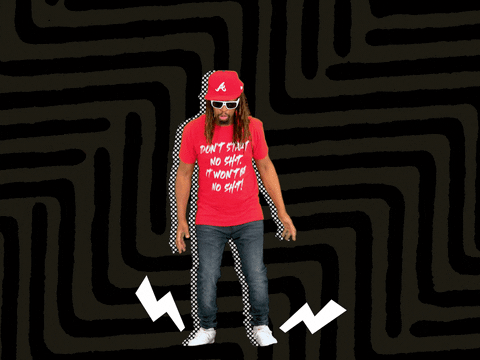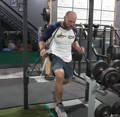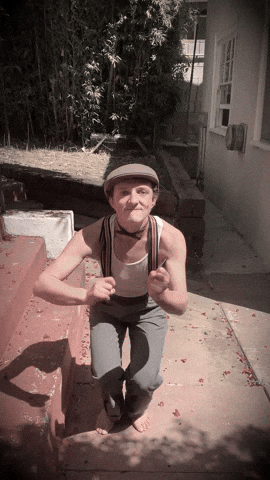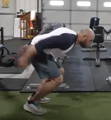5 Best Bodyweight Exercises To Jump Higher
You need to understand the proper mechanics of jumping. You need to know how to do a countermovement. You need to know how to use your arms to jump higher. You need to know how to dip your chest properly as well.
When you jump, you need to know how to absorb energy. Doing a counter-movement requires being elastic. Elasticity is key. People talk about being rigid in the ankles and rigid in the hip. Elasticity is the better term. You have to absorb energy while keeping it elastic to people yourself when jumping as far or as high as possible.
Starting the jump, you dip. The dip is where you see the force absorption. There is a nice quarter squat with the knees, ankles, and hips to propel the body. You come through with the arms and propel yourself vertically. For a broad jump, the chest stays forward and the shin angle changes to propel the body forward.

1. Side Slow Step Up
You don’t need to back squat double body weight to do plyometrics. However, you do need to have strong quads, hamstrings, back, explosive posterior chain, and tendon strength.
On a box, you want to reach the leg out slightly while the toe is dorsiflexed. The eccentric needs to be controlled on the way down slowly. You then drive back up. You will improve your knee joint health and light up your quads and glutes. Training the quads and glutes together will improve hip extension.
You can do 4 to 6 sets of 4 to 6 reps on each leg; the movement is a unilateral exercise.
2. Backward Stair Step Up
Tendon strength is important when it comes to jumping and having healthy joints.
Walking up steps backward creates a huge pump in the quads. You can even do this exercise on a hill. The movement leads to tremendous quad strength which helps when planting to make a jump.
3. Double Leg Jump To Single Leg Deceleration
Triple flexion occurs through the ankle, knee, and hip; all very important to deceleration. As you age, you will find you struggle with deceleration.
As an athlete, start off sitting on a box and jumping with a double leg bound into a single leg stop. Rotate the single-leg landing. Once the body warms up as an athlete, focus on the quick single-leg landing to build elasticity. Pause in the landing. You will want to do your weak side first.
Do 5 sets of 3 jumps on each leg.
4. Band Split Squat Jumps
Using accommodating resistance is a great way to lead to a better vertical jump. You can do this through pre-fatigue as well.

Whether being fatigued, having tension set, or just general fitness, this exercise is great.
Using a PowerLastic band set up inside a rig (or using dumbbells or cinder blocks), you will get into a split position holding a quarter squat with the band around your neck. You may want to be slightly flexed with the front leg. Hold the position for about 10 seconds and then rapidly fire jumps. Then switch the forward leg, hold for 10 seconds, and then rapidly jump one after the other. You can even do the movement by rotating which leg is forward and which leg is backward.
The exercise requires a lot of coordination and can lead to a lot of fatigue. Make sure you take ample rest between sets.

5. Knee Jump To Tuck Jump For Height
This exercise will help with hip extension and rapid force absorption.
As an athlete, you need to extend your hips all the time. You need to hit hip extension. The knee jump to tuck jump for height requires a lot of glute power to get from the knees to the feet. The movement is boom, boom. It is complicated.
Have your hips come back to the knees, then your hips extend rapidly, land, and explode into the tuck jump. It is an aggressive exercise. You will benefit greatly from resting for 2 to 3 minutes between sets.
You want to hit 5 sets of 3 total reps.
6. Depth Drop To Bound
Trying to jump higher comes down to reusing energy. Or in other words, how elastic are you? Think of the elasticity of a deer or kangaroo. That is how you want to be to jump high and far.
On a platform no higher than 14’. It is plenty high. The goal is to take vertical energy and transfer it into horizontal movement.

Pay attention to how you ground and what is done with the chest. It is also important to pay attention to how the arms cycle as well. Focus on proper mechanics. As the depth drop occurs, drop the chest slightly and swing the arms back. When done right, you can launch yourself horizontally.
Do 5 sets of 2 reps. Remember to stick to the landing. It is also fun to do with a partner and compete over who can jump farther.
Recap
A great thing about jump training and plyometrics is that the exercises can be done almost universally anywhere. In most cases, a gym is not needed. You can walk backward up the steps at work. You can go to the local park and do bounds. Improving your ability to jump higher and farther can be done using the bodyweight exercises from above. No matter what the goal, the bodyweight movements will help you cultivate your power.
Related Posts
Blog Topics

Yo, It's Dane
Welcome to the Garage Strength Blog, where it is my goal to provide you with the experience and knowledge I've gained in the strength and conditioning world over many years of learning from both successes and failures. I train elite-level athletes in a multitude of sports from the high school to professional levels, already producing 5 Olympics and 30+ National Champions. If you want to be the next champion I train, check out my strength programs below!
Start Training With Me

Join for free educational videos EVERY WEEK on strength coaching and athletic performance
